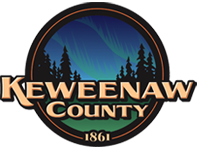About Our County
Pronounced KEY-wah-nah, an Ojibway word that means "the crossing place" or "land crossing between two bodies of water." It refers to traversing Portage Lake to reach the Keweenaw Peninsula.
County Statistics
Founded:
March 11, 1861
County Seat: Eagle River
Population: 2156
(2010 census est.)
4.3 people per sq. mi.
Location: 47.4772 N, 88.1550 W
Townships: Allouez, Eagle Harbor, Grant, Houghton, Sherman
Time has told the story of Keweenaw
Ancient Indians honored the land and celebrated its awesome beauty. But the wealth of Keweenaw County lay beneath the surface of its rugged hills, for this was the only place in the world where native copper was found in any considerable quantity.
Early native peoples began mining and using copper over 7,000 years ago. When Europeans arrived in the area, attempts at mining were at first unsuccessful. By the 1840’s, "copper fever" took hold, creating one of the first mineral mining booms in the New World. In 1843, modern copper mines began production. Since then, over ten percent of all the copper in the world was produced in the Copper Country.
When the natural Keweenaw Waterway was dredged and expanded in the 1860s for shipping, the Keweenaw Peninsula became an island surrounded by Lake Superior. Of all the counties in the United States, Keweenaw County has the highest proportion of water area to total area. In essence, approximately 90 percent of the county is under the surface of Lake Superior with 541 square miles of land and 5,425 square miles of water.
The "Big Lake" controls the region’s climate. Spring is brief and cool, summer is sunny and mild, and autumn arrives in September with a blaze of color. In winter, snow normally covers the land from Thanksgiving to late April with the average annual snowfall ranging from 180 to 250 inches.
The diversity of the landscape--from singing sand beaches to the oldest known lava formations on earth can be found along the shores. An all-encompassing view from 700- to 900-foot peaks takes in vast strands of forest, lakes, hills and water.
Spring creates the illusion of an emerald island as the hardwoods take on new leaves. Fall offers up a quilt of autumn colors combining with the greens of conifers that blanket the land in beauty.
Fort Wilkins State Park, established in 1844, has been restored. Mining history comes alive at the Quincy and Delaware Mine complexes.
A golf course, hiking and biking trails, skiing and snowmobile trails, safe harbors, migratory bird flyways all add to the urge to wander...and wonder.
Welcome to Keweenaw County The land of ocean blue, emerald green, blazing russet, gold, orange and red; and in the winter, a pure white blanket of quiet and peace. Every season renews the spirit, we urge you to visit year-round and see every glorious season.
The least populated county in Michigan, our villages are home to proud descendants of miners who each have a story to tell of the "copper country". We are proud of our sense of place, tucked within the beautiful forests of hardwood trees and white pines. Stop awhile, and you’ll hear a story or two from the locals.
The Communities
Ahmeek
This Community lies near the southern boundary of Keweenaw County on U.S. Highway 41 and essentially serves as one of the two gateways into the county.
Mohawk
Like its neighbor Ahmeek, Mohawk is a former mining town and is the largest town in the county. In 1896, a lumberman found some native copper in the area. Exploration by Joseph E. Gay proved the value of the find, and in 1898, the Mohawk Mining Company was formed and began operation. The village developed with the mine and was named for it.
Gay
Not far from Mohawk is Gay, a community so named because of mining operations initiated by Joseph E. Gay. Gay is the site of a former copper ore stamping mill where the ore, consisting of native copper metal and volcanic rock, was smashed into progressively smaller pieces until the copper became dislodged from the host rock.
Copper Harbor and Eagle Harbor
These two communities are located on the north shore of the Keweenaw Peninsula about 10 miles apart. Copper Harbor is the more easterly of the two and serves as the northern endpoint (or beginning, depending on your point of view) of U.S. Highway 41, the other end terminating at Miami, Florida.
The majority of residents of Eagle Harbor are seasonal residents who live elsewhere during the rather severe winters. But more and more residents are making the community their year-round home.
Copper Harbor, with a state park and a jumping off point for access to Isle Royale National Park, located 48 miles to the northwest in Lake Superior, will continue to attract residents and visitors alike. Nature-based tourism currently pays an important role, especially the public-access facilities that allow people to enjoy Lake Superior. Tourism and recreation on undeveloped lands is on the increase in the county particularly with the development of excellent trail systems for both non-motorized and motorized year-round sports.








